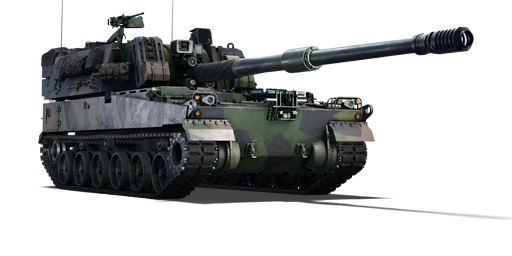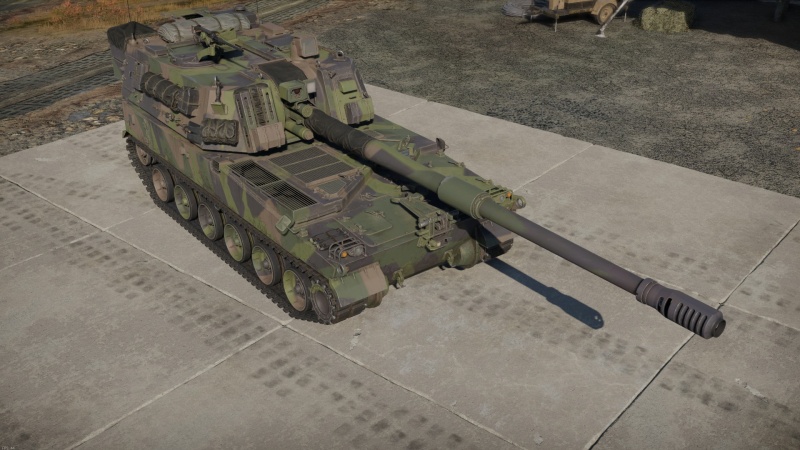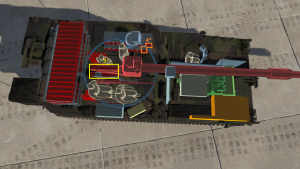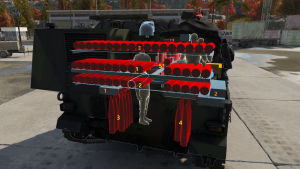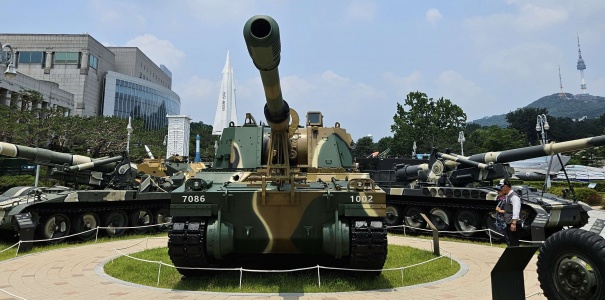Difference between revisions of "VIDAR"
m (Image of the XK-9 added to provide visual aids of the prototype K9) |
(History revision / Partial description redux) |
||
| Line 7: | Line 7: | ||
== Description == | == Description == | ||
<!-- ''In the description, the first part should be about the history of the creation and combat usage of the vehicle, as well as its key features. In the second part, tell the reader about the ground vehicle in the game. Insert a screenshot of the vehicle, so that if the novice player does not remember the vehicle by name, he will immediately understand what kind of vehicle the article is talking about.'' --> | <!-- ''In the description, the first part should be about the history of the creation and combat usage of the vehicle, as well as its key features. In the second part, tell the reader about the ground vehicle in the game. Insert a screenshot of the vehicle, so that if the novice player does not remember the vehicle by name, he will immediately understand what kind of vehicle the article is talking about.'' --> | ||
| − | |||
| − | Introduced in [[Update "Sons of Attila"]], the VIDAR is fitted with excellent optics and fire control system. At its BR, it is one of the few vehicles with both thermal imaging system and a laser rangefinder | + | The '''{{Specs|name}}''' is a self-propelled artillery system fielded by Norway since 2019. The system is an export version of the South Korean K9 Thunder Self-Propelled Artillery Gun, which Norway acquired the system to replace its aging M109A3GNMs of American origin. The orders so far have been in two batches, the initial 2017 contract for 24 K9s and an extra order in 2022 for 4 more systems. The system has some differences compared to the South Korean version, most notably the ODIN fire control system developed domestically and direct-fire enabling equipment. This system was given to the ''Artilleribataljonen'' of the ''Brigade Nord'', the only artillery unit in the Norwegian army. |
| + | |||
| + | Introduced in [[Update "Sons of Attila"]], the VIDAR is fitted with excellent optics and fire control system. At its BR, it is one of the few vehicles with both a thermal imaging system and a laser rangefinder. Its best round is a 155 mm HE shell that is capable of destroying most tanks, but requires very good aiming when it faces heavily armoured targets like the [[T-55AM-1]]. The vehicle also has a fairly poor turret rotation speed and no stabilizer, and, being an artillery system, the armor protection is fairly thin and its gun depression limited. However, it has good mobility for a vehicle of its size, and a very good reverse speed of 42 km/h. The VIDAR is best suited for highly mobile warfare, moving around rapidly after firing a few accurate shells towards your enemies. | ||
== General info == | == General info == | ||
| Line 158: | Line 159: | ||
== History == | == History == | ||
<!-- ''Describe the history of the creation and combat usage of the vehicle in more detail than in the introduction. If the historical reference turns out to be too long, take it to a separate article, taking a link to the article about the vehicle and adding a block "/History" (example: <nowiki>https://wiki.warthunder.com/(Vehicle-name)/History</nowiki>) and add a link to it here using the <code>main</code> template. Be sure to reference text and sources by using <code><nowiki><ref></ref></nowiki></code>, as well as adding them at the end of the article with <code><nowiki><references /></nowiki></code>. This section may also include the vehicle's dev blog entry (if applicable) and the in-game encyclopedia description (under <code><nowiki>=== In-game description ===</nowiki></code>, also if applicable).'' --> | <!-- ''Describe the history of the creation and combat usage of the vehicle in more detail than in the introduction. If the historical reference turns out to be too long, take it to a separate article, taking a link to the article about the vehicle and adding a block "/History" (example: <nowiki>https://wiki.warthunder.com/(Vehicle-name)/History</nowiki>) and add a link to it here using the <code>main</code> template. Be sure to reference text and sources by using <code><nowiki><ref></ref></nowiki></code>, as well as adding them at the end of the article with <code><nowiki><references /></nowiki></code>. This section may also include the vehicle's dev blog entry (if applicable) and the in-game encyclopedia description (under <code><nowiki>=== In-game description ===</nowiki></code>, also if applicable).'' --> | ||
| − | The '''{{Specs|name}}''' is an export version of the South Korean K9 Thunder Self Propelled Artillery System, in service with the Norwegian Army. Norway decided to acquire a total of 24 K9 Thunder systems as well as 6 K10 resupply vehicles to replace their aging American-made M109A3GNM. | + | The '''{{Specs|name}}''' is an export version of the South Korean K9 Thunder Self Propelled Artillery System, in service with the Norwegian Army. Norway decided to acquire a total of 24 K9 Thunder systems as well as 6 K10 ammo resupply vehicles in 2017 to replace their aging American-made M109A3GNM. The K9 won out in the competition which consisted of the CAESAR wheeled artillery system, the K9, German PzH2000 and M109G, with the M109G and K9 being the final two contenders before the K9 was selected in December of 2017 as the winner. |
| + | |||
| + | The VIDAR is operated by the only artillery unit in the Norwegian Army, the ''Artilleribataljonen'' of the ''Brigade Nord.'' The vehicle was manufactured by the company Hanwha Land Systems, deliveries started in 2019 and finished between 2020 and 2021. All units were considered operational by the Norwegian Army by January 1st, 2022. In November of 2022, Norway inked an additional deal to import 4 more K9 SPHs and 8 more K10 ammo resupply vehicles, raising the total to 28 VIDARs and 14 K10s soon to be in service. | ||
| − | The | + | The K9 Thunder was developed by South Korea, based on experiences with the K55 license-produced M109 howitzer. The vehicle was developed to be fully compatible with NATO ammunition, and to have good mobility to perform counterbattery fire and change positions rapidly. The K9's first prototype was unveiled in 1996. The contract for its development was awarded to Samsung Aerospace Industries and just 3 years later in 1999 the ROK Army started to receive its first units of the vehicle. The first nation to acquire the production rights for the system was Turkey. |
| − | The K9 | + | The K9 has seen combat action in the Yeonpyeong bombardment of 2010, an artillery exchange between South Korean and North Korean soldiers. In this incident, 6 K9 systems from the South Korean Marine Infantry opened fire against North Korean positions. During the incident, some criticism was leveled at the K9 due to its return rate of fire being 1 round every 90 seconds - however, this was due to the fact that the K9's ammunition reserves were empty from the military exercise just minutes prior, meaning soldiers were running to the ammunition depots to fetch shells to fire back. The Korean Army deemed the K9's protection during the incident to be adequate against North Korean field gun shrapnel, and increased production of the K9 by a hundred extra units by 2011. This led to the K9s positioned near the border also retaining internal ammunition at all times, in case of a similar incident in the future. |
| − | The K9 has | + | The K9 has received very good export deals. Competing in the international markets with very powerful systems like the American M109 and German Pzh2000, it has sold more than 1,700 units, including those for South Korea. Turkey has also fitted their own version of the system, the T-155 Firtina, with 300 units expected to be deployed. |
| − | + | In December of 2013, the program to improve the K9's performance was passed, which led to the K9A1. The K9A1 modification upgraded the FCS of the K0 up to K55A1 standard, added GPS navigation on top of the original INS system, the addition of an APU and a night vision periscope for the driver as well as a rear view camera. The software was also updated from a DOS based framework up to a Windows based digital FCS, to provide a graphics based fire control system for the crew to enhance performance. | |
== Media == | == Media == | ||
Revision as of 01:21, 27 March 2024
Contents
Description
The Versatile InDirect ARtillery is a self-propelled artillery system fielded by Norway since 2019. The system is an export version of the South Korean K9 Thunder Self-Propelled Artillery Gun, which Norway acquired the system to replace its aging M109A3GNMs of American origin. The orders so far have been in two batches, the initial 2017 contract for 24 K9s and an extra order in 2022 for 4 more systems. The system has some differences compared to the South Korean version, most notably the ODIN fire control system developed domestically and direct-fire enabling equipment. This system was given to the Artilleribataljonen of the Brigade Nord, the only artillery unit in the Norwegian army.
Introduced in Update "Sons of Attila", the VIDAR is fitted with excellent optics and fire control system. At its BR, it is one of the few vehicles with both a thermal imaging system and a laser rangefinder. Its best round is a 155 mm HE shell that is capable of destroying most tanks, but requires very good aiming when it faces heavily armoured targets like the T-55AM-1. The vehicle also has a fairly poor turret rotation speed and no stabilizer, and, being an artillery system, the armor protection is fairly thin and its gun depression limited. However, it has good mobility for a vehicle of its size, and a very good reverse speed of 42 km/h. The VIDAR is best suited for highly mobile warfare, moving around rapidly after firing a few accurate shells towards your enemies.
General info
Survivability and armour
The VIDAR is based on ROKA's K9A1 Thunder SPH, although the vehicle can be said as one of the most modern vehicle in-game, the overall survivability is still not for frontline operations due to its nature of a SPH. The purpose of protection for SPH is for stopping close-call shrapnel from injuring the crew, supporting vehicles like such are usually deployed at the rear of battlefield to support the assault forces - this is no exception for VIDAR.
Thanks to the overall improved armor technology, the hardened armor on both the chassis and turret can now make sure even basic 20 mm ammunition (generally used by non-combat SPAA or as auxiliary weapon by some medium tanks) cannot harm the crew from any direction at ranges of 300 m or above, but do not take it as a medallion to go for the frontline - even weakest autocannons can still tear down the vehicle with relative ease through the turret neck or at point blank range.
The SPG is extremely sturdy and will not take overpressure damage unless obliterated by another artillery tank or hit into three very specific weak spots - the belly right above the tracks next to the turret (not going to happen under normal circumstances), the turret ring (while not impossible, might be difficult to hit before VIDAR fires) or the gun breech (only vulnerable to 105+ mm HE and poses risk of the cannon catching the shell), so anyone trying to parry VIDAR with HESH/HE/ATGM thinking "it's just another SPG" is going to have a very bad time. The kinetic shells will easily penetrate, so having a teammate to cover the flank against random snipers is always a good idea to extend VIDAR's service life for as long as possible.
As for the crews, thanks to the long hull and large engine block, shrapnel from enemy shots to the hull might have a hard time to cause lethal damage to the turret crew (but costs the driver); if enemy players are aware of the huge turret, the crew of four can rotate as generally only two of them will be knocked down by the projectile, unless the detonation of up to 48 shells at the rear of the turret happens, in which case there will be huge fireworks as the turret flies hundreds of meters away.
Armour type:
| Armour | Front (Slope angle) | Sides | Rear | Roof |
|---|---|---|---|---|
| Hull | 40 mm | 35 mm Top 35 mm Bottom |
35 mm | 10 - 35 mm |
| Turret | 35 mm Turret front 20 mm Gun mantlet |
35 mm | 35 - 45 mm | 35 mm |
| Cupola | 20 mm | 20 mm | 20 mm | 20 mm |
Notes:
Mobility
| Game Mode | Max Speed (km/h) | Weight (tons) | Engine power (horsepower) | Power-to-weight ratio (hp/ton) | |||
|---|---|---|---|---|---|---|---|
| Forward | Reverse | Stock | Upgraded | Stock | Upgraded | ||
| Arcade | 73 | 44 | 48 | 1,420 | 1,908 | 29.58 | 39.75 |
| Realistic | 68 | 40 | 884 | 1,000 | 18.42 | 20.83 | |
Modifications and economy
Armaments
Main armament
For countering possible enemies, Hyundai WIA developed the domestic 155 mm CN98 L/52 howitzer for K9 Thunder using NATO standard 155 mm ammunition, it is no exception for the export VIDAR for Norway; thanks to its rather fast reload rate (for the first three shells on the "ready-rack") the and varieties of ammunition, CN98 makes VIDAR a fearsome SPH even against "doomsday tank" and early-Cold War tanks, enemy aircraft will also fall victim of it if VT shell is loaded, turning it into a 155 mm anti-aircraft cannon. Do note that the gun does not have an autoloader and upon severe crew loss the reload speed advantage is lost.
| 155 mm CN98 | Turret rotation speed (°/s) | Reloading rate (seconds) | |||||||||||
|---|---|---|---|---|---|---|---|---|---|---|---|---|---|
| Mode | Capacity | Vertical | Horizontal | Stabilizer | Stock | Upgraded | Full | Expert | Aced | Stock | Full | Expert | Aced |
| Arcade | 48 | -4°/+70° | ±180° | N/A | 8.8 | 12.2 | 14.8 | 16.4 | 17.4 | 7.80 | 6.90 | 6.36 | 6.00 |
| Realistic | 5.9 | 7.0 | 8.5 | 9.4 | 10.0 | ||||||||
Ammunition
| Penetration statistics | |||||||
|---|---|---|---|---|---|---|---|
| Ammunition | Type of warhead |
Penetration @ 0° Angle of Attack (mm) | |||||
| 10 m | 100 m | 500 m | 1,000 m | 1,500 m | 2,000 m | ||
| M107 | HE | 61 | 61 | 61 | 61 | 61 | 61 |
| M107 (PF) | HE-VT | 61 | 61 | 61 | 61 | 61 | 61 |
| OE F3 | HE | 61 | 61 | 61 | 61 | 61 | 61 |
| Shell details | ||||||||||||
|---|---|---|---|---|---|---|---|---|---|---|---|---|
| Ammunition | Type of warhead |
Velocity (m/s) |
Projectile mass (kg) |
Fuse delay (m) |
Fuse sensitivity (mm) |
Explosive mass (TNT equivalent) (kg) |
Ricochet | |||||
| 0% | 50% | 100% | ||||||||||
| M107 | HE | 563 | 43.1 | 0.3 | 0.1 | 9.14 | 79° | 80° | 81° | |||
| OE F3 | HE | 935 | 44.4 | 0.3 | 0.1 | 9 | 79° | 80° | 81° | |||
| Proximity-fused shell details | ||||||||||||
|---|---|---|---|---|---|---|---|---|---|---|---|---|
| Ammunition | Type of warhead |
Velocity (m/s) |
Projectile mass (kg) |
Fuse delay (m) |
Fuse sensitivity (mm) |
Arming distance (m) |
Trigger radius (m) |
Explosive mass (TNT equivalent) (kg) |
Ricochet | |||
| 0% | 50% | 100% | ||||||||||
| M107 (PF) | HE-VT | 580 | 43.1 | 0 | 0 | 300 | 3 | 9.14 | 79° | 80° | 81° | |
| Smoke shell characteristics | ||||||
|---|---|---|---|---|---|---|
| Ammunition | Velocity (m/s) |
Projectile mass (kg) |
Screen radius (m) |
Screen deploy time (s) |
Screen hold time (s) |
Explosive mass (TNT equivalent) (g) |
| M110 | 563 | 40.8 | 21 | 5 | 30 | 50 |
Ammo racks
| Full ammo |
Ammo
Type |
1st rack empty |
2nd rack empty |
3rd rack empty |
4th rack empty |
5th rack empty |
Visual discrepancy |
|---|---|---|---|---|---|---|---|
| 48 | Projectiles
Propellants |
34(+14)
31(+17) |
19(+29)
21(+27) |
10(+38)
3(+45) |
3(+45)
1(+47) |
1(+47)
N/A |
Yes |
Machine guns
| 12.7 mm M2HB | ||||
|---|---|---|---|---|
| Mount | Capacity (Belt) | Fire rate | Vertical | Horizontal |
| Pintle | 600 (200) | 575 | -6°/+15° | ±180° |
Usage in battles
VIDAR's CN98 (155mm) cannon can only inflict damage with HE rounds, so players should be at least aware of how Overpressure works in War Thunder. Having some knowledge of where vehicles can be overpressured (turret rooftops, the upper plates of the hull, areas around hull ammunition storages and so on) is the bare minimum to be able to do any consistent damage to enemy vehicles.
The VIDAR can generally consider two types of enemies as its most noteworthy adversaries; vehicles with stabilized guns, which can fire on the move, and enemy APCs, IFVs, and SPAAGs with high-calibre, rapid-firing heavy machine guns or autocannons. While the VIDAR is constructed mainly out of 35 mm hardened steel plates as opposed to the thin aluminium of its older artillery brethren such as the M109s, it still requires smart planning and quick moving to remain intact. Any enemy main gun will make short work of the VIDAR, and the thin plating can only resist HMG and certain autocannon rounds. Most enemy vehicles must therefore be considered lethal; while the vast majority of 12.7 mm (.50 cal) and 14.5 mm HMG rounds can be shrugged off, anything bigger is much more likely to either fully penetrate or at least severely harm the vehicle. Many 20 mm APDS rounds will go through the armour at normal engagement ranges. Any sort of HVAP or APDS bigger than 20 mm will ignore the steel plates; APFSDS will not even think of it as a barrier between itself and the crew or ammunition load! Here, enemy IFVs such as the Bradleys, Type 89, or BMP series can be considered dangerous opponents to face. An enemy missile hitting the VIDAR is more likely than not to destroy the vehicle.
Using the very good acceleration and turning speeds of the VIDAR will help the commander move quickly from one favourable position to another. Using natural cover such as trenches, ditches, muddy riverbanks, or small clusters of trees will help conceal the vehicle while remaining within viewing distance of the battlefield. The excellent sights will provide the opportunity to spot and engage enemies from afar, and the near-instant-use laser rangefinder will automatically raise or lower the gun to the right horizontal elevation for the targeted enemy who finds himself at the receiving end of the L/52 cannon.
The choice of HE-VT means the VIDAR can successfully engage aircraft. Using the laser rangefinder, one can target helicopters at range, both stationary and moving. With some practice, it becomes relatively easy to engage moving aircraft using the high muzzle velocity, good sights, and good proximity fuzing radius. Enemy planes flying directly against the VIDAR can be "swatted" out of the sky with ease.
Pros and cons
Pros:
- Great firepower
- Fast reload rate for a SPH
- Agile and nimble chassis
- Thermal imager and laser rangefinder
- 35 mm average all-around armour
- Can't be overpressured from <120 mm HE
- Cannot be penetrated by HMGs
Cons:
- Weak survivability
- Only partial protection from autocannons
- Poor gun depression
- Relatively small first-stage ammo rack
History
The Versatile InDirect ARtillery is an export version of the South Korean K9 Thunder Self Propelled Artillery System, in service with the Norwegian Army. Norway decided to acquire a total of 24 K9 Thunder systems as well as 6 K10 ammo resupply vehicles in 2017 to replace their aging American-made M109A3GNM. The K9 won out in the competition which consisted of the CAESAR wheeled artillery system, the K9, German PzH2000 and M109G, with the M109G and K9 being the final two contenders before the K9 was selected in December of 2017 as the winner.
The VIDAR is operated by the only artillery unit in the Norwegian Army, the Artilleribataljonen of the Brigade Nord. The vehicle was manufactured by the company Hanwha Land Systems, deliveries started in 2019 and finished between 2020 and 2021. All units were considered operational by the Norwegian Army by January 1st, 2022. In November of 2022, Norway inked an additional deal to import 4 more K9 SPHs and 8 more K10 ammo resupply vehicles, raising the total to 28 VIDARs and 14 K10s soon to be in service.
The K9 Thunder was developed by South Korea, based on experiences with the K55 license-produced M109 howitzer. The vehicle was developed to be fully compatible with NATO ammunition, and to have good mobility to perform counterbattery fire and change positions rapidly. The K9's first prototype was unveiled in 1996. The contract for its development was awarded to Samsung Aerospace Industries and just 3 years later in 1999 the ROK Army started to receive its first units of the vehicle. The first nation to acquire the production rights for the system was Turkey.
The K9 has seen combat action in the Yeonpyeong bombardment of 2010, an artillery exchange between South Korean and North Korean soldiers. In this incident, 6 K9 systems from the South Korean Marine Infantry opened fire against North Korean positions. During the incident, some criticism was leveled at the K9 due to its return rate of fire being 1 round every 90 seconds - however, this was due to the fact that the K9's ammunition reserves were empty from the military exercise just minutes prior, meaning soldiers were running to the ammunition depots to fetch shells to fire back. The Korean Army deemed the K9's protection during the incident to be adequate against North Korean field gun shrapnel, and increased production of the K9 by a hundred extra units by 2011. This led to the K9s positioned near the border also retaining internal ammunition at all times, in case of a similar incident in the future.
The K9 has received very good export deals. Competing in the international markets with very powerful systems like the American M109 and German Pzh2000, it has sold more than 1,700 units, including those for South Korea. Turkey has also fitted their own version of the system, the T-155 Firtina, with 300 units expected to be deployed.
In December of 2013, the program to improve the K9's performance was passed, which led to the K9A1. The K9A1 modification upgraded the FCS of the K0 up to K55A1 standard, added GPS navigation on top of the original INS system, the addition of an APU and a night vision periscope for the driver as well as a rear view camera. The software was also updated from a DOS based framework up to a Windows based digital FCS, to provide a graphics based fire control system for the crew to enhance performance.
Media
- Skins
- Videos
See also
Links to the articles on the War Thunder Wiki that you think will be useful for the reader, for example:
- reference to the series of the vehicles;
- links to approximate analogues of other nations and research trees.
External links
| Sweden tank destroyers | |
|---|---|
| Strv m/41 derivatives | Spj fm/43-44 · Sav m/43 (1944) · Sav m/43 (1946) · Pvkv II · Pvkv III |
| Ikv 72/103 | Ikv 72 · Ikv 103 |
| Pvkv m/43 | Pvkv m/43 (1946) · Pvkv m/43 (1963) |
| ATGM | UDES 33 · Pbv 302 (BILL) · Pvrbv 551 |
| Other | SAV 20.12.48 · Bkan 1C |
| Norway | VIDAR |
| Sweden premium ground vehicles | |
|---|---|
| Light tanks | ▄T-26E · Strv m/39 · Pbil m/40 · Strv m/41 S-I · CV 90105 |
| Medium tanks | Sherman III/IV · Strv 81 (RB 52) · Strv 103-0 · Leopard 1A5NO2 · Christian II |
| Tank destroyers | Ikv 73 · SAV 20.12.48 · VIDAR |


